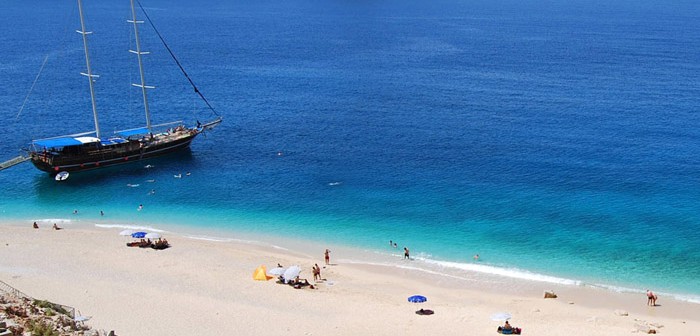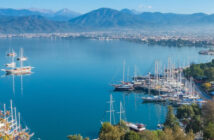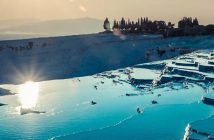National Parks, Nature Parks, Nature Reserve Areas And Wildlife Reserve Areas Near Antalya
NATIONAL PARKS NEAR ANTALYA
Four National Parks in Antalya borders. The working area of Antalya National Park Department contains geomorphologic and geologic features along with many matchless beauties, including archaeological and aesthetical characteristics; unique rich plantation cover and animal group, where the most intense tourism activities are carried out in Turkey.
Olympos Bey Mountains (Beydaglari) Coast National Park
Olympos Bey Mountains (Beydaglari) Coast National Park is in the west of Antalya City, and 30 km northeast of Finike. The park crosses the Antalya – Kemer – Kumluca state highway. The area is in western Taurus Mountains, with a geological structure predominantly made up of limestone and serpentine rocks, and ecological characteristics of the Mediterranean. Olympos Bey Mountains Coast National Park which has been declared by the Board of Ministers as a national park in 16.03.1972 and has a 34.425 hectares of area when the settlements have been left out of the borders of National Parks, begins from Sarisu located at the southwestern part of Antalya and reaches out to Gelidonya Foreland parallel to the Mediterranean across the Kemer-Kumluca shoreline.
Olympos Bey Mountains Coast National Park
Gulluk (Güllük) Mountain (Termessos) National Park
The Gulluk (Güllük) Mountain National Park, where the ancient city of Termessos is located, covers an area of approximately seven thousand hectares (7.000 ha). The national park is 25 km northwest of Antalya’s city centre. The main attraction, Termessos, was among the cities of Pisidia, a region bordering Pamphylia that has remained relatively untouched because of its remoteness. It attracts numerous visitors each year not only for the ancient city itself, but also due to the biological diversity of the wildlife around it. Termessos has an interesting place in history and is referred to as the “impenetrable city” because of its unique location. Visitors are impressed by its imposing theatre, odeon, gymnasium, cisterns, necropolis (ancient theatre) and many remains spread over a fairly large area. There is also an information centre and various dining and recreational facilities, which cater to the needs of visitors, providing them with a pleasant experience following a memorable trip.
Gulluk Mountain Termessos National Park
Koprulu (Köprülü) Canyon National Park
The Koprulu (Köprülü) Canyon National Park lies in the Manavgat and Serik districts to the east of Antalya and has an area of approximately 40 thousand hectares 40.000 ha). The Koprulu Canyon National Park takes its name from the Oluk Bridge, which was built over the Kopruçay (Köprüçay) River in Roman times. Southwest of Oluk Bridge is the the Bugrum (Büğrüm) Bridge, which stretches over the canyon where the Gokcesu (Gökçesu) River flows. This bridge was built in the Roman period. Fifteen kilometres (15 km) north of the Oluk Bridge lies the renowned ancient city of Selge. Together with the endemic plants and animalssituated in an undisturbed environment makes the Koprulu Canyon National Park one of the most popular sightseeing areas among tourists. The central section of the Kopruçay (Köprüçay) River is one of the most important rafting centres of Turkey. There are many mountain settlements and villages dotted throughout the wide expanses of the Koprulu Canyon National Park. Besides sports and leisure in a magnificent landscape, visitors also have an opportunity to see rural life for themselves.
Koprulu Canyon National Park
Saklikent (Saklıkent) National Park
Saklikent (Saklıkent) National Park was established on the provincial border of Antalya in Kas (Kaş) district and Mugla (Muğla) in Fetihye district. Saklikent (Saklıkent) National Park was established in and around Saklikent (Saklıkent) Gorge, which is traversed by the Karacay (Karaçay) stream one of the tributaries of the Esen (Eşen) River. The majority of the 500 km2 large national park lies in the province of Antalya. The trip starts from the footpath that is attached to steep canyon walls with iron joints. The stream runs below the pathway which takes visitors to the main source within the canyon. The water consists of white foam that rushes from below. Around the river source there are dining and other recreational facilities, which create a welcome diversion during the trip. The walking tour in the imposing 20 km long, winding canyon that continuously expands and narrows, rightly justifies its reputation.
Saklikent National Park
Altinbesik (Altınbeşik) Cave National Park
The Altinbesik (Altınbeşik) Cave National Park takes its name from the cave of the same name and is situated within Ürünlü Village (Unulla) in the Ormana (Erymna) area of İbradı district. It is approximately 200 km2 large. The underground lake accumulates the source waters of the Manavgat River before it transforms into a river and it is a true natural wonder that can also be traversed by boat. The Altınbeşik Cave Lake is part of the submerged waters of Lake Gembos. The water discharged from Manavgat River has carved out anatural bridge in the cave and unusual formations in cave walls document and demonstrate the power of this flow. The extraordinary formations of the Altınbeşik Cave and the unperturbed natural environment around the area evoke admiration among visitors. The number of visitors has increased since road improvements were made and recreational facilities at the entrance of the cave were built. On the other hand, the meticulously preserved Ürünlü Village in the Akseki-İbradı region reflects the architecture of all structures unique to Anatolia. It is an unforgettable experience for the visitor to walk around with the guidance of the hospitable villagers.
Altinbesik Cave National Park
NATURE PARKS NEAR ANTALYA
Guver (Güver) Canyon Nature Park
The Guver (Güver) Canyon Nature Park with its outstanding scenery and remarkable geologicalformations is visited by many local and foreign guests. It is situated in the western part of the Dosemealti (Döşemealtı) district in Yukarı Karaman in the Duzlercami (Düzlerçamı) region. The canyon is more than 100 metres deep and is a remarkable reserve for wildlife. Rainfall from the northern mountains accumulates and after traversing the canyon, finally empties into the sea. The observation decks around the canyon offer views of the city as well as the Bey Mountains (Beydağları).
The Kursunlu (Kurşunlu) Waterfall Nature Park
The main feature is the Kursunlu (Kurşunlu) Waterfall formed by the Kucuk Topalli (Küçük Topallı) Stream. It is a well-maintained park with pathways alongside the stream and small bridges traversing it. The rich animal life and trekking and picnic facilities make it very popular with tourists.
Incekum (İncekum) Nature Park
The Incekum Nature Park is situated by the sea in the district of Alanya. This park is especially well-known for its forest cover and the beach which carries its name. Before it was declared a Nature Park, it was a favourite recreation area used for daytrips. Today it is visited by local and foreign tourists in great numbers who stay in nearby facilities.
Mavikent Nature Park
The name of the Nature Park located at the western part of the Gulf in Kumluca comes from Mavikent District nearby. Before being declared a Nature Park, it was simply used by the locals as a recreation area.
NATURE RESERVE AREAS NEAR ANTALYA
Çiglikara (Çığlıkara) Nature Reserve Area
Çiglikara (Çığlıkara) Nature Reserve Area is located west of the Gulf on the Teke Peninsula in Elmali (Elmalı) District and was established to preserve the endangered cedar trees and the large number of endemic plant species and wild animals. The Çiglikara (Çığlıkara) Nature Reserve Area has outstanding views of the Caybogazi (Çayboğazı) Dam and monument trees are located in the area.
Alacadag (Alacadağ) Nature Reserve Area
Alacadag (Alacadağ) Nature Reserve Area is situated in Finike District south of Elmali (Elmalı). There are more than twenty tree species in the nature reserve area. It is one of the region’s most important ecosystems, with an unspoiled vegetation and protected monument trees. The slopes of Alacadag (Alacadağ ) have one of the most striking views of the Bay of Finike-Kumluca and offer visitors a pleasant trip in a scenic location.
Dibek Nature Reserve Area
Dibek Nature Reserve Area was established in the Dibek Forest in Kumluca District. It is one of the major ecosystems in the region, particularly due to the variety of trees, the most common of which is the cedar tree.
WILDLIFE RESERVE AREAS NEAR ANTALYA
Sivridag (Sivridağ) Wildlife Reserve Area
This wildlife reserve in the vicinity of Sivridag (Sivridağ) in Antalya’s Konyaalti district was established to protect mountain goats, wild boars, hares and partridges in their own natural environment.
Gidengelmez Dağları Wildlife Reserve Area
This wild reserve area in the Gidengelmez Mountains in Akseki district to the north of the gulf has a large number of mountain goats, bears, wild boars, hares, foxes and badgers. The isolation of the Gidengelmez Mountains gives it an additional appeal.
Uzumdere (Üzümdere) Wildlife Reserve Area
This wildlife reserve area is located along the shores of the Manavgat River in İbradı District, a typical highland district. The main species found in this area is the mountain goat. It is also rich in the number of partridges, hares, wild boars and martens.
Dimcayi (Dimçayı) Wildlife Reserve Area
Situated in Alanya District this wildlife area covers the upper parts of the Dimcayi (Dimçayı) Valley. Again the main species in the area is themountain goat, but large number of wild boars, hares, foxes and martens are also seen.
Duzlercami (Düzlerçamı) Wildlife Reserve Area
The main species that can be found in the Duzlercami (Düzlerçamı) area just north of Antalya’s city centre are mountain goats and fallow deer. Besides these two main species, wild boars, rabbits, foxes, martens, caracals and partridges live in the reserve. The Düzlerçamı Wildlife Reserve Area is popular with many visitors as it allows for the observation of mountain goats and fallow deer.
Gundogmus (Gündoğmuş) Wildlife Reserve Area
This lies within the Gundogmus (Gündoğmuş) District in the midst of the Taurus Mountains and is marked out as a wildlife preserve. The wildlife around Gündoğmuş has been better preserved than other areas, because of its isolation. One of the main elements of wildlife in the Taurus Mountains are mountain goats, rabbits, martens and foxes in addition to the presence of partridges.
Kibriscayi (Kıbrısçayı) Wildlife Reserve Area
This covers an area starting from the northern end of Kaş District and extends to the foot of the Akdag (Akdağ) Mountains. The most significant species found here is the mountain goat. In addition to wild boars, hares, foxes and martens, badgers in the Kıbrısçayı Valley Floorare among the most common species in this area.
Sarikaya-Akdag (Sarıkaya-Akdağ ) Wildlife Reserve Area
This covers a very wide expanse around the Oluklu Highland beginning from Sarıkaya Cliffs north of Finike and extends towards theSusuz Akdağ Mountain. It is mainly a wildlife reserve area for mountain goats, wild boars, rabbits and foxes.
THE LAKES REGION NEAR ANTALYA
The Lakes Region north of the Gulf of Antalya is among the most remarkable areas of Anatolia in terms of natural wealth. Located mainly in the provinces of Burdur and Isparta, national parks, nature parks, nature reserve areas and wildlife reserve areas have been established to protect and preserve plants and wild animals.
Lake Kovada National Park
The small Lake Kovada in the Egirdir (Eğirdir) district of Isparta is a real gem of nature with its charming scenery and wildlife. The lake is easy to reach and has lush foliage. It is a haven for many bird species ranging from partridges to ducks and there are squirrels, foxes, martens, badgers, wild boars and rabbits to be found as well. Lake Kovada has a circumference of 20 kilometers and with its untouched nature is a hidden paradise for camping enthusiasts.
Kovada Lake National Park
Kizildag (Kızıldağ) National Park
The Kizildag (Kızıldağ) National Park in Isparta’s Sarkikaraagac (Şarkikaraağaç) district is noted for its high oxygen producing capacity. This is probably due to the extensive forest cover at the slopes of Buyuksivri (Büyüksivri) Hill, just south of the district’s centre, and consists of cedar, larch, juniper and other trees. The Kızıldağ National Park is not only important in terms of the presence of trees, but for its endemic plant diversity and wildlife. The large Lake Beyşehir to the south of the national park is not only renowned for its scenery but also for its climate and rich vegetation.
Yazili (Yazılı) Canyon Nature Park
The Yazılı Canyon Nature Park is situated within the borders of Sütçüler district in Isparta province. It derives its name from the rock inscriptions on the canyon walls, which includes the writings of the famous Stoan philosopher Epictetus. St. Paul crossed this road during his journey from Perge to Yalvaç, which is also the most direct route connecting the Antalya region to the north. Because of its well-maintained sections, this road has been referred to as the “King’s Road,” but is more commonly known as “St. Paul’s Trail” or the “Way of the Cross.” The canyon, which is traversed by a road, is noted for its extraordinary views and for its delicious trout.
Mount Gelincik Nature Park
Mount Gelincik Nature Park is situated on the western shore of Lake Eğirdir. With its unique ecosystem and stunning views of the lake from the summits of the Kapıdağı and Çamdağı Mountains, this is one of the region’s important natural treasures. The Mount Gelincik Nature Park has an abundance of cedar trees and to a lesser extent juniper and larch trees. Many bulbous plants also grow in the park. The Mount Gelincik Nature Park is used by the villagers of the Senirkent, Egirdir, and Uluborlu districts as a pasture ground. As in almost all nature conservation areas, this park enables visitors a first hand experience of traditional rural life and nature.
Golcuk (Gölcük) Nature Park
Lake Gölcük, a few kilometers southwest of Isparta’s city centre, is a crater lake. Unique for its natural formations Gölcük Nature Park is a highly popular place with local and foreign tourists. This recreational area attracts plenty of visitors for its trees variety, as well as animals such as various bird species, turtles and snakes.
Lake Salda Nature Park
Lake Salda is located within the boundaries of the Yeşilova district in the Burdur province and is among the deepest lakes of Anatolia, if not the deepest. Lake Salda Nature Park is a popular excursion spot for visitors where they can savour regional dishes and trout.
Serenler Hill Nature Park
The Serenler Hill on the shores of Lake Burdur attracts many visitors with its picnic areas and an observation deck that offers outstanding views of the lake. Serenler Nature Park is one of the most visited places in the region.
Kasnak Oak Forest Reserve Area
The Kasnak Oak Forest Reserve Area lies within the Yukarı Gökdere village between Lake Eğirdir and Lake Kovada. Since this area has been declared a reserve, oak trees which previously sustained heavy damage over the years, will now be preserved for future generations.
Kasnak Oak Forest Reserve Area
Kargı Village Sweetgum Forest Nature Reserve Area
The sweetgum oil extracted from the sweetgum tree was well known in ancient times for treating skin ailments and for its other therapeutic qualities. One of the places where sweetgum trees can be found is the vicinity of Kargı village in the Aksu Valley of Burdur. The Kargı Village Sweetgum Forest Nature Reserve Area was established to preserve these cherished trees for years to come.
Coastline of Turkey
Antalya, Paradise on Earth
Map Of National Parks In Turkey
Natural Protection Areas in Turkey
Wallpapers of Nature in Turkey
Maps of Antalya




